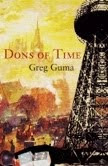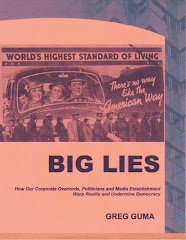Part One: A Crisis of Fact
The technology of journalism has advanced more in the last decade than in the 100 years before. Yet more and more, print and electronic media fill airtime and space with “advertorials” and questionable “news” -- some of it fake -- produced by public relations firms and even governments. The race for higher circulation and audience shares has placed a premium on titillation and superficiality, producing to an ill-informed electorate. Journalistic professionalism and credibility are in free fall, and truth has been seriously devalued.
Compounding the problem, corporate ownership and bottom line thinking appear to mean that fewer responsible and trained journalists will be available in the future, especially to cover developments in foreign countries. US television networks employ at least a third fewer correspondents than they did 20 years ago. Radio newsroom staffs shrank by 44 percent between 1994 and 2001. Foreign coverage by broadcast and cable networks has shrunk at least 70 percent since the 1980s. Sad to say, but professionalism in reporting may be going the way of shortwave radios, fax machines, and the single-lens reflex camera.
The uncomfortable truth is that the First Amendment doesn't guarantee that democracy will be fair, that people will be well or truthfully informed, or that the press will be competent.
Society is experiencing what has been called a crisis of fact, leaving people with little to trust or believe. As a result, more and more they consume only information that reinforces their opinions. And, according to Alexander Cockburn, journalists aren’t helping. The first law of the profession today, he says, is “to confirm existing prejudice, rather than contradict it.”
We live in an age defined by fraud and scandal – questionable elections, corrupt religious leaders, fabricated accounting that devastates the savings of thousands, doped-up athletes, and plagiarized and phony news. Even scholars have been caught plagiarizing parts of their books. It’s become so common that there is a new peer-reviewed academic journal: Plagiary: Cross Disciplinary Studies in Plagiarism, Fabrication, and Falsification. One the fastest growing educational Web businesses investigates whether student terms papers have been plagiarized. So far, investigators have found that at least 30 percent of the papers submitted for verification have been plagiarized, at least in part.
Publications frequently use something they call “photo illustration” – basically the fabrication of images using digital tools. It may sound harmless, but given the power of images it has the potential of warping public perception in the service of biased or inaccurate stories.
Local TV, the primary source of news about civic life for most people, covers less and less political news. A survey of the 2006 election season by the University of Wisconsin concluded that “local television news viewers got considerably more information about campaigns from paid political advertisements than from actual news coverage.”
Given all this, how do the young get their news in the Internet age? The truth is the many don’t bother. But most younger people who want to know what’s happening don’t turn to print newspapers, or even radio and TV. They scan online versions of papers, check the sites of research organizations, and surf political blogs – many of them operated by academics and think tanks that have figured out how to appeal to a popular audience by mixing commentary with breaking news, analysis, and research.
According to the blog search engine Technorati, 120,000 web logs are created each day, and the total number is close to 100 million. Most of these blogs are primarily devoted to diary accounts, opinions, theories, and so one. But a new type of website has also emerged – the Carefully-Researched Weblog, or CROG. These include, for example, the site on Middle East affairs maintained by Juan Cole and a health policy Crog on the Daily Kos written by someone calling himself Dr. Steve B. Many people also use Google’s popular “alert” function. If you want to know about a specific topic, Google will send you a daily message with links to the latest information from writers, bloggers, and sites. Still, the best information on the Internet continues to come from Websites run by print organizations.
However, the emergence of “citizen journalism” and the “new media” have led to the notion that professional journalists are no longer as necessary. Everyone can be a journalist, we hear, and this will promote a conversation among equals. The idea is that citizen journalists can assemble, edit, even create of their own news; that the more options we have -- and the less control traditional media has over what is relevant -- they better offer we will be.
But this presumes that professionalism doesn’t matter, and that standards aren’t that important in providing information. At this point, unfortunately, the “new media” acknowledge few rules. And to be frank, professional journalism isn’t so simple. For example, knowing the difference between news, opinion and commentary is a serious challenge. Journalists work hard to develop skills like how to conduct fair and constructive interviews, how to find relevant and complete – not merely convenient – information, how to see various sides of an issue, and how to convey what they find out clearly and accurately. Without such skills, the public is vulnerable to distortions, biased reports, and blatant falsehoods.
According to a 2006 State of the News Media report by the Project for Excellence in Journalism, only five percent of blog postings included “what would be considered journalistic reporting.” And the origins of the vast majority of blog stories can be traced back to newspapers. Who will do the reporting if they fade away?
For all its benefits, the “blogosphere” is also accelerating social fragmentation. Many blogs and Websites attract only like-minded people, creating a self-segregated news and information environment that serves the interests of extremists and ideologues on both the “left” and “right.” It’s not so different from the partisanship that characterized the press in the early 19th Century. Truth and facts are becoming debatable notions. This makes it far more difficult for people to reach agreement or even have a civil discussion, and easier for demagogues to ignore reality for the sake of pushing initiatives based on convenience or ideology.
In The Elements of Journalism, authors Bill Kovach and Tom Rosenthal write, “In the end, the discipline of verification is what separates journalism from entertainment, propaganda, fiction, or art.” Thus far, the blogosphere is weak on checking what it presents as fact.
Originally posted on March 21, 2008. Material in this four-part series was first presented in January 2008 at a KPFT strategic planning retreat.
Next: Will Newspapers Survive?































No comments:
Post a Comment